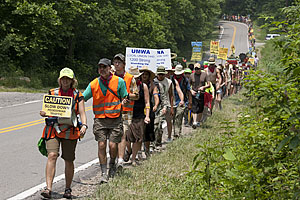Union and environmental activists marched for five days through the southern West Virginia coal fields in mid-June to defend a piece of land that is sacred to both. Led by members of Mine Workers Local 1440, they walked 50 miles from Marmet to historic Blair Mountain.
Blair Mountain is threatened with mountaintop removal, in which the top of a mountain is sliced off and deposited in a nearby valley to get at the coal underneath. It is devastating to both the environment and the local economy. Besides scarring the landscape and polluting the water of much of southern West Virginia and eastern Kentucky, mountaintop removal employs only a fraction of the workforce required for underground mining.
Good union jobs are disappearing and towns are dying in one of the poorest states as the coal operators remove great wealth from the mountains.
Union miners also marched to highlight coal companies’ atrocious safety record. One of the companies that owns much of Blair Mountain—Alpha Natural Resources—recently purchased Massey Energy, the company responsible for the Upper Big Branch disaster last year that killed 29 miners.
Another company—Arch Coal—already has permits for the mountain. In destroying Blair Mountain, the companies would wipe out the site of a key piece of labor history.
Sacred Site
Ten thousand union coal miners marched the same 50-mile route in 1921 in an attempt to bring miners from the southern part of the state into the union. They were met at Blair Mountain by company gunmen and sheriff's deputies who fired machine guns and dropped bombs on them from planes. In the five-day battle that followed, an estimated million rounds of ammunition were fired and more than 100 people were killed. The miners surrendered only after the U.S. Army intervened, and it was not until 1933 that southern West Virginia was organized.
While this year's march was peaceful, it had its share of tension. Although many local residents oppose mountaintop removal, others have cast their lot with the industry, clinging to the dwindling number of jobs that coal provides. “Coal Puts Food on Our Table,” read the sign carried by one heckler as the march passed through the town of Sharples.
Nearby, members of UMWA Local 2286 waved a sign denouncing Local 1440 for participating in the march. The international union, while opposed to the destruction of Blair Mountain, did not support the march.
Before the final two-mile march to the top of the mountain, environmental attoney Robert F. Kennedy, Jr. told a rally that Blair Mountain is “the Gettysburg of the union movement in our country.”
About a thousand people joined the final march, among them Electrical Workers (IBEW) from Parkersburg, state employees (members of the United Electrical Workers), teachers from Cincinnati, Steelworkers, and Communications Workers.
Jim West is a freelance photographer and the former editor of Labor Notes.







